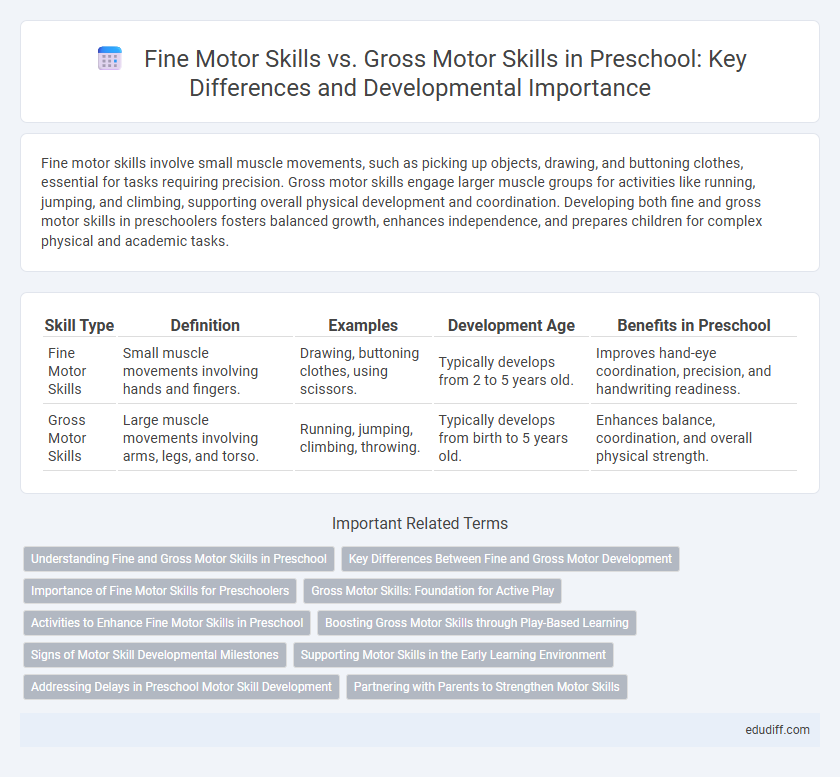Fine motor skills involve small muscle movements, such as picking up objects, drawing, and buttoning clothes, essential for tasks requiring precision. Gross motor skills engage larger muscle groups for activities like running, jumping, and climbing, supporting overall physical development and coordination. Developing both fine and gross motor skills in preschoolers fosters balanced growth, enhances independence, and prepares children for complex physical and academic tasks.
Table of Comparison
| Skill Type | Definition | Examples | Development Age | Benefits in Preschool |
|---|---|---|---|---|
| Fine Motor Skills | Small muscle movements involving hands and fingers. | Drawing, buttoning clothes, using scissors. | Typically develops from 2 to 5 years old. | Improves hand-eye coordination, precision, and handwriting readiness. |
| Gross Motor Skills | Large muscle movements involving arms, legs, and torso. | Running, jumping, climbing, throwing. | Typically develops from birth to 5 years old. | Enhances balance, coordination, and overall physical strength. |
Understanding Fine and Gross Motor Skills in Preschool
Fine motor skills in preschool involve precise movements using small muscle groups, such as finger dexterity for writing, buttoning, and using utensils, which are crucial for early academic tasks and daily self-care. Gross motor skills encompass larger muscle activities like running, jumping, climbing, and balancing, essential for overall physical development, coordination, and active play. Understanding these distinct motor skills helps educators create targeted activities that support comprehensive child development, promoting both cognitive growth and physical health.
Key Differences Between Fine and Gross Motor Development
Fine motor skills involve the coordination of small muscles in the hands and fingers to perform precise movements such as grasping, writing, and buttoning, crucial for tasks like drawing and self-care. Gross motor skills engage larger muscle groups responsible for movements like running, jumping, and climbing, essential for overall physical mobility and balance in preschool children. The key differences lie in the muscle groups involved, the precision of movements, and their impact on a child's ability to interact with their environment and develop independence.
Importance of Fine Motor Skills for Preschoolers
Fine motor skills involve the coordination of small muscles, particularly in the hands and fingers, essential for preschoolers to master activities like writing, buttoning clothes, and using scissors. Developing fine motor skills at this stage supports hand-eye coordination, cognitive growth, and early literacy development. Strengthening these skills early promotes independence and prepares children for academic tasks requiring precision and control.
Gross Motor Skills: Foundation for Active Play
Gross motor skills involve large muscle movements essential for running, jumping, and climbing, forming the foundation for active play in preschool children. Developing these skills enhances balance, coordination, and spatial awareness, critical for participating in group activities and sports. Emphasizing gross motor development supports physical health and promotes social interaction through collaborative play experiences.
Activities to Enhance Fine Motor Skills in Preschool
Activities such as threading beads, cutting with child-safe scissors, and using tweezers to pick up small objects significantly enhance fine motor skills in preschoolers by improving hand-eye coordination and dexterity. These exercises promote precision and control essential for writing and self-care tasks. Integrating sensory play with clay or finger paints further strengthens small muscle development critical for fine motor proficiency.
Boosting Gross Motor Skills through Play-Based Learning
Boosting gross motor skills in preschoolers through play-based learning enhances coordination, balance, and muscle strength essential for physical development. Activities like climbing, jumping, and throwing encourage large muscle group engagement while promoting social interaction and cognitive growth. Integrating diverse play experiences supports holistic development by complementing fine motor skill refinement with robust gross motor foundations.
Signs of Motor Skill Developmental Milestones
Preschoolers typically develop fine motor skills, such as grasping small objects and drawing shapes, by ages 3 to 5, while gross motor skills involve activities like running, jumping, and climbing. Key signs of motor skill developmental milestones include the ability to hold a crayon properly, stack blocks, and balance on one foot for several seconds. Monitoring these milestones helps identify any delays requiring early intervention to support physical and cognitive growth.
Supporting Motor Skills in the Early Learning Environment
Supporting motor skills in the early learning environment requires tailored activities targeting both fine motor skills, such as manipulating small objects, grasping pencils, and threading beads, and gross motor skills like running, jumping, and climbing. Educators prioritize hands-on materials and structured play to enhance dexterity, hand-eye coordination, balance, and muscle strength, essential for preschoolers' overall development. Integrating diverse motor skill exercises promotes cognitive growth, social interaction, and readiness for academic tasks.
Addressing Delays in Preschool Motor Skill Development
Fine motor skills in preschool involve precise hand and finger movements like grasping crayons or buttoning clothes, while gross motor skills include larger movements such as running, jumping, and climbing. Addressing delays in motor skill development requires targeted activities like puzzles and bead stringing for fine motor improvement, and obstacle courses or ball games to enhance gross motor abilities. Early intervention through structured play and therapy supports neural development and boosts children's confidence in performing daily tasks.
Partnering with Parents to Strengthen Motor Skills
Partnering with parents strengthens both fine and gross motor skills in preschool children by integrating targeted activities into daily routines, such as using utensils for fine motor development and outdoor play for gross motor growth. Collaborative efforts include providing parents with resources and strategies to encourage hand-eye coordination, finger dexterity, balance, and large muscle control at home. Consistent communication between educators and parents ensures tailored support that promotes comprehensive motor skill advancement during early childhood.
Fine motor skills vs Gross motor skills Infographic

 edudiff.com
edudiff.com